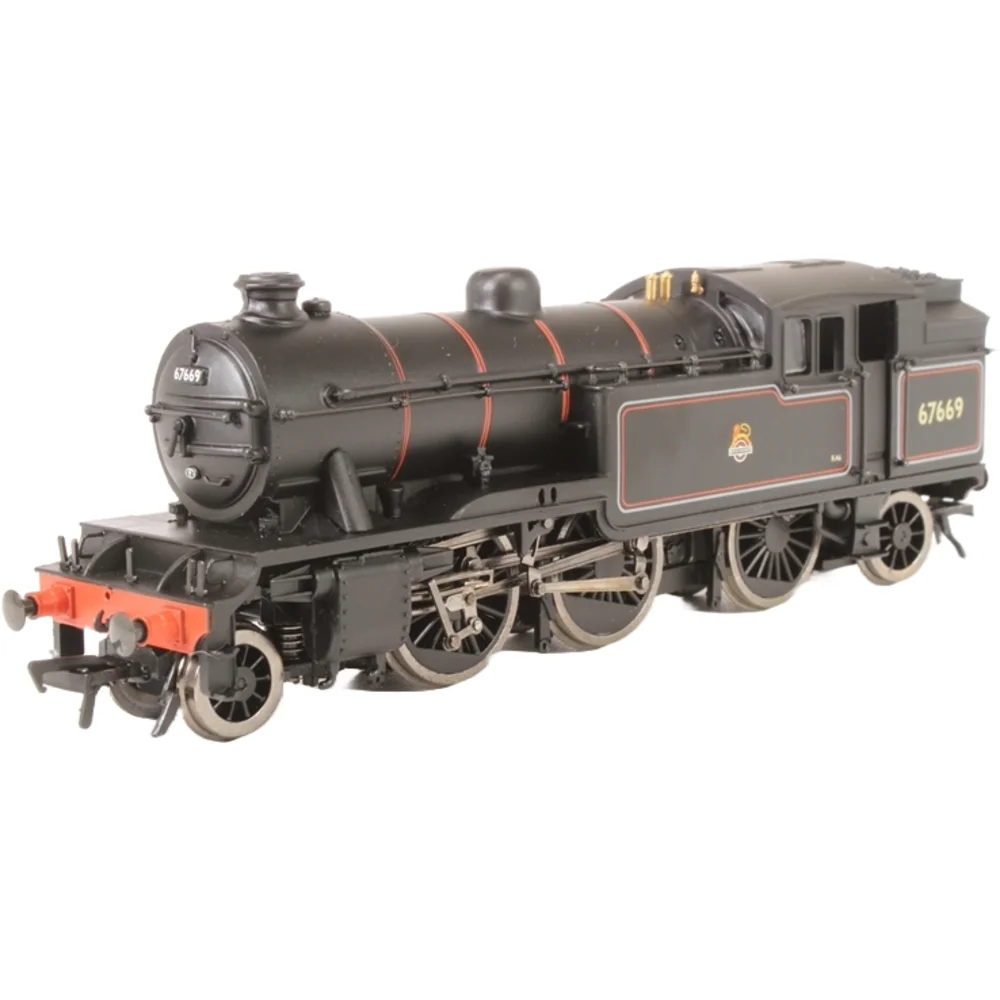Bachmann 31-609A
London & North Eastern Railway V3 67669 British Railways Lined Black with Early Emblem
Tooling
The Bachmann Branchline V1/V3 2-6-2T was introduced in 1991–92 as part of Bachmann’s early OO gauge range following their acquisition of Mainline tooling. These suburban tank locomotives, designed by Sir Nigel Gresley for the LNER, were popular for their versatility on passenger and mixed-traffic duties. At the time, the model represented a significant step forward in British RTR steam locomotives, though it retained the split-chassis technology typical of the era.
Tooling Features
- Scale: OO gauge (1:76), designed for 16.5mm track.
- Construction: Plastic bodyshell with moulded details; cab glazing was basic and recessed.
- Detailing: Integral handrails, moulded rivets, and simplified pipework. No separately fitted parts typical of later “super-detail” models.
- Couplings: Tension-lock couplers mounted on the chassis; no NEM pockets.
Mechanical & Electrical
- Chassis: Split-chassis design with electrical pickup through the chassis halves.
- Motor: Mabuchi FK130 can motor driving the centre axle via gears; praised for longevity.
- Drive: All three driving axles powered; reasonable haulage for its size.
- Minimum Radius: Recommended 2nd radius (approx. 438mm).
- Lighting: None.
- Weighting: Moderate weight from chassis block; adequate for suburban trains.
DCC Capability
Not DCC-ready. Hard-wiring a decoder was considered impractical due to the split-chassis design, making conversion difficult and rarely attempted.
Liveries Produced
- LNER Apple Green (1923–1947)
- LNER Black (1923–1947)
- BR Plain Black (1948–1980)
- BR Green with Early Emblem (1948–1957)
- BR Black with Early Emblem (1949–1957)
- BR Black with Late Crest (1957–1968)
Reviews & Commentary
At launch, the model was considered robust and good value, though detailing was basic compared to later standards. Enthusiasts praised its running qualities when new, but over time issues emerged:
- Strengths: Smooth running when well-maintained; durable motor.
- Weaknesses: Vulnerable to split-chassis deterioration (cracked plastic muffs, worn plating); poor cab detail; heavy moulded features.
Modern reviewers often describe it as “outdated but nostalgic,” noting its place between Airfix-era tooling and contemporary super-detail models.
Media & Social Media
Video reviews and forum discussions highlight the model’s historical significance and mechanical reliability, but caution against second-hand purchases due to age-related failures. Popular YouTube channels have featured the V1/V3, often labelling it “worst detail but best runner” among older Bachmann tanks.
Interesting Notes
- The tooling remained in production until the mid-2000s before being replaced by a fully retooled version in 2016.
- Collectors value mint boxed examples for nostalgia rather than operational use.
Class & Prototype
- Class: London & North Eastern Railway V3
- Traction: Steam
- Built: 1939-1940
- Total Built: 10
No prototype found.
Operator & Livery
- Operator: British Railways
- Livery: Lined Black with Early Emblem
British Railways transformed Britain's fragmented rail network into a unified national system following nationalisation on 1st January 1948. Created from the "Big Four" companies under the Transport Act 1947, BR operated most of Great Britain's railways until rebranding as British Rail in 1965, managing over 20,000 route miles and inheriting nearly 20,000 locomotives of diverse designs.
The organisation pioneered standardisation through its revolutionary BR Standard locomotive programme (1951-1960), producing 999 advanced steam engines under Robert Riddles' direction. These included the versatile Britannia Pacifics, mighty 9F freight engines, and mixed-traffic classes that incorporated the best features from all predecessor companies. The 1955 Modernisation Plan accelerated diesel and electric traction development, creating fascinating mixed-traction operations.
Notable achievements included establishing unified locomotive classification systems, introducing distinctive corporate liveries, and managing the complex transition from steam to modern traction. BR's six regional structure preserved operational diversity whilst enabling standardisation of practices, signalling, and rolling stock that had eluded private enterprise for over a century.
The BR era represents steam traction's final flowering alongside emerging diesel technology, creating unparalleled locomotive variety. Today, this heritage remains highly popular with railway enthusiasts through extensive preserved fleets, heritage railway operations, and comprehensive model ranges from manufacturers like Hornby, Bachmann, and Dapol, making BR subjects essential for authentic post-war British railway modelling across all scales.
British Railways' lined black livery was designated for mixed-traffic and secondary passenger locomotives from 1949, following pure LNWR style with black base colour and elaborate red, cream (off-white), and grey lining patterns. The lining specification comprised 5/8" grey, 1/8" cream, 1½" black, and ¼" red bands, with the layout consistent with LNWR practice including deep and shallow valances lined along bottom edges only, unlike green engines. The first lined black engines appeared in August 1948 when Hall 5954 appeared so painted, becoming one of the first to carry the "Lion and Wheel" emblem around the same time.
A wide range of engines was eligible for this livery, from powerful V2s and Counties down to tiny Southern Terriers, encompassing County, Hall, Grange, Manor, Saint, Prairie tanks, and numerous pre-grouping designs of varied shapes and sizes. This created many variations and interpretation problems due to the diverse locomotive types involved, with regional differences in splasher lining treatment—the Eastern Region used red-only splasher lining, whilst the Southern Region evolved from inset to edge lining styles. The emblem was positioned centrally on tender sides above the middle axle box, with the Western Region favouring larger sizes on tenders and bigger tank engines. An interesting period detail saw number plates routinely painted red from late 1949 to early 1952, adding colour contrast to the otherwise black scheme. This livery represented BR's commitment to standardising mixed-traffic operations whilst maintaining the decorative traditions that distinguished passenger-rated locomotives from plain freight engines.
